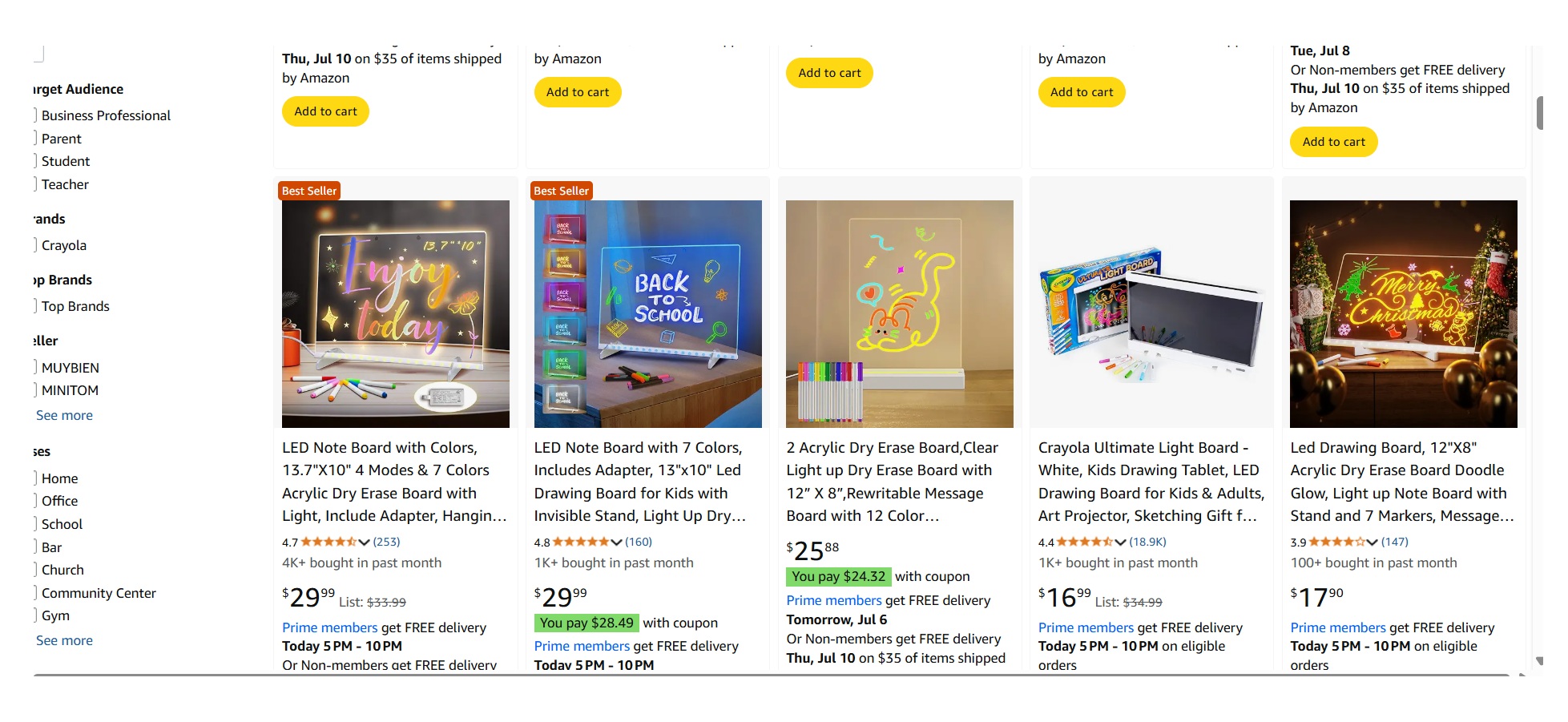Lifestyle Image as Main Image
Asking this of an Amazon rep, will Amazon ever understand that for many products, unless the main image shows it 'in use', the customer can't understand how it will look in their particular place of use? I have been a product merchant for decades, designing not only products, but packaging and marketing materials as well. If you don't show products as they will be used in a home, garden or other interior setting, sales will not be optimized as the customer can't envision it for themselves. Most retailers know this, including Walmart who has always allowed the use of lifestyle main images, giving them a marketing advantage. Why doesn't Amazon understand this? In some cases, Amazon uses lifestyle for their own products like these: https://www.amazon.com/AmazonBasics-Hypoallergenic-Quilted-Mattress-Topper/dp/B01KBKI1NG/, https://www.amazon.com/Amazon-Basics-Jacquard-Geometric-Microfiber/dp/B0DSF7K1B8/ & https://www.amazon.com/Amazon-Basics-Geometric-Lightweight-Waterproof/dp/B0DWSVJ8T1/. While many packaged products DO look better and can sell themselves very well silo'ed on a white background, others simply can't. I can only hope at some point Amazon realizes there's a lot of lost revenue for items that can't.
Lifestyle Image as Main Image
Asking this of an Amazon rep, will Amazon ever understand that for many products, unless the main image shows it 'in use', the customer can't understand how it will look in their particular place of use? I have been a product merchant for decades, designing not only products, but packaging and marketing materials as well. If you don't show products as they will be used in a home, garden or other interior setting, sales will not be optimized as the customer can't envision it for themselves. Most retailers know this, including Walmart who has always allowed the use of lifestyle main images, giving them a marketing advantage. Why doesn't Amazon understand this? In some cases, Amazon uses lifestyle for their own products like these: https://www.amazon.com/AmazonBasics-Hypoallergenic-Quilted-Mattress-Topper/dp/B01KBKI1NG/, https://www.amazon.com/Amazon-Basics-Jacquard-Geometric-Microfiber/dp/B0DSF7K1B8/ & https://www.amazon.com/Amazon-Basics-Geometric-Lightweight-Waterproof/dp/B0DWSVJ8T1/. While many packaged products DO look better and can sell themselves very well silo'ed on a white background, others simply can't. I can only hope at some point Amazon realizes there's a lot of lost revenue for items that can't.
6 yanıt
Seller_xo4Akj7FBBnfC
You're unlikely to get a meaningful response from an Amazon rep on this—mainly because the examples you linked are from the Amazon Basics house brand. As most sellers have discovered, the rules for Amazon’s own products don’t apply to the rest of us, especially when bending those rules gives their in-house listings a competitive edge.
We’ve long suspected that the “white background only” rule has less to do with improving conversions and more to do with reducing Amazon’s enforcement workload.
But that rigidity comes at a real cost for products that rely on visual context to be understood. In our case, the product requires a user-supplied pressure washer—yet we regularly get returns from customers who wrongly assume, based on the isolated main image, that it connects directly to a garden hose.
An in-use photo as the main image would help prevent that confusion—and the needless waste of perfectly good products that end up discarded because they can’t be resold.
Seller_roNdLQpqbVoOH
Perhaps because Amazon is relying more and more heavily on automation, machines, AI, bots...
And, as far as I know, automation is unable to "understand."
Manny_Amazon
Hello @Seller_j4cBNs8gstrke,
Thanks for posting regarding this issue. Amazon generally doesn’t allow lifestyle images as the main image on detail pages to maintain consistency and clarity across product listings. The main reason is that Amazon wants to provide customers with a clear, unambiguous view of the product they’re considering purchasing. The Product image requirements page goes over this in detail.
Here are the key reasons behind this policy:
- Consistency: Amazon requires main images to have a pure white background (RGB color values: 255, 255, 255) to create a consistent shopping experience for customers across search and product detail pages.
- Product Focus: The main image should show the product as 85% of the image, allowing customers to see the item clearly without distractions.
- Accuracy: Main images must accurately represent the product and show only the product that’s for sale, with minimal or no propping.
- Clarity: Lifestyle images often include additional elements that might confuse customers about what’s actually included with the purchase.
- Zoom Functionality: Amazon prioritizes images that allow for zoom functionality, which has been shown to enhance sales. Lifestyle images may not always meet the technical requirements for this feature.
However, it’s worth noting that Amazon does allow for lifestyle images in limited product types, such as beds, bed frames, mattresses, rugs, rug pads, and sofas. For these specific categories, a lifestyle image can be used as the main image.
For other product categories, while lifestyle images aren’t permitted as the main image, they can be incredibly valuable as additional images. These can be included to show the product in use or in context, helping customers better understand its features and benefits.
I understand this policy might be frustrating if you believe a lifestyle image would better showcase your product. However, Amazon’s goal is to create a consistent, clear shopping experience across all product categories. Rest assured, you can still use lifestyle images in your additional product photos to highlight your item’s features and benefits.
I hope this information helps.
Regards,
- Manny
Seller_xo4Akj7FBBnfC
I’ll add that while Amazon prohibits lifestyle images as main product images—ostensibly to maintain consistency and avoid customer confusion—it has no problem displaying paid ads with their AI-generated lifestyle images that are often wildly inaccurate, misleading, or physically impossible.
These ad images appear above organic results, meaning they’re the first thing a buyer sees when searching within our product category.
For example, here’s a sponsored ad for ASIN B0DJP1DNZL featuring an AI-generated, sci-fi-style image that’s poorly composed and physically impossible—far more likely to confuse customers than a clear, real-world lifestyle photo ever would as a main image.

